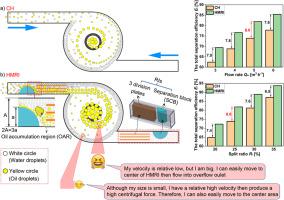Journal of Environmental Chemical Engineering ( IF 7.4 ) Pub Date : 2021-05-13 , DOI: 10.1016/j.jece.2021.105642 Lin Liu , Lixin Zhao , Yian Sun , Sheng Gao , Minzheng Jiang , Minghu Jiang , Diego Rosso

|
The inlet section of hydrocyclone has a significant effect on separation efficiency. However, in most existing studies the inlet of conventional hydrocyclones (CH) only serves as a channel for the mixed liquid to enter the hydrocyclone body. Based on CH's tangential inlet with a rectangular section, a novel hydrocyclone with medium rearrangement internals (HMRI) was designed and the rearrangement internals (RIs) were installed inside the inlets. The RIs include one separating block and 3 division plates following the block. Thus, the rearrangement of immiscible media can be achieved after passing through this inlet, i.e., media with different densities flow into different layers. Most of the rearranged low-density phase flows directly into the central area of HMRI. Meanwhile, most of high-density phase flows to the wall zone, which is beneficial for the subsequent centrifugal separation process in HMRI’s body. Taking the oil-water mixture as the example, three kinds of separating blocks, semi-cylindrical block (SCB), triangular prism block (TPB), and trapezoidal body block (TBB) were designed and compared to no-block cases (conventional inlet) through simulations. Results showed that RIs with SCB displayed excellent rearrangement effect as well as a low pressure drop. Additionally, the comparison between CH and HMRI was conducted via oil-phase distribution, velocity distribution, and separation efficiency. Our results show that the separation efficiency of the novel HMRI was 6.4-8.0% higher than the traditional CH, under various operating conditions. The application potential of HMRI in biological processes for wastewater treatment was also analysed and discussed.
中文翻译:

内部介质重排的水力旋流器的分离性能
水力旋流器的入口部分对分离效率有重大影响。但是,在大多数现有研究中,传统水力旋流器(CH)的入口仅用作混合液体进入水力旋流器主体的通道。基于CH的矩形切向入口,设计了一种具有中等重排内部(HMRI)的新型水力旋流器,并在入口内部安装了重排内部(RI)。RI包括一个分隔块和紧随该块的3个分隔板。因此,在通过该入口之后,可以实现不混溶介质的重排,即,具有不同密度的介质流入不同的层中。重新排列的大多数低密度相直接流入HMRI的中央区域。同时,大多数高密度相流到壁区,这对于HMRI体内随后的离心分离过程是有益的。以油水混合物为例,设计了三种分离块,半圆柱块(SCB),三角棱柱块(TPB)和梯形车体块(TBB),并与无块情况进行了比较(常规进水)通过模拟。结果表明,具有SCB的RI表现出出色的重排效果以及较低的压降。此外,通过油相分布,速度分布和分离效率对CH和HMRI进行了比较。我们的结果表明,在各种操作条件下,新型HMRI的分离效率比传统CH高6.4-8.0%。还对HMRI在生物处理废水中的应用潜力进行了分析和讨论。










































 京公网安备 11010802027423号
京公网安备 11010802027423号